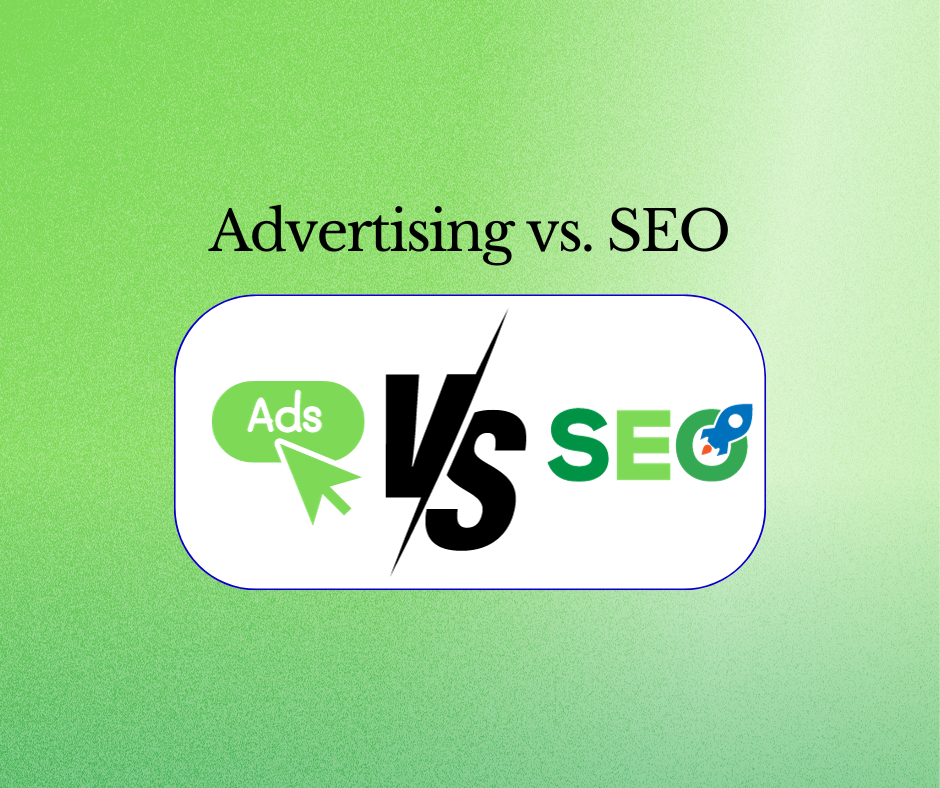
Google Ads: How to Execute a Successful Google Search Campaign with GreenFlow SEM Digital Marketing
How to Set Up a Successful Google Search Campaign (Expert Mode)
In today's digital landscape, online advertising has become an essential part of a comprehensive marketing strategy. Among the various platforms available, Google Ads stands out as a powerful tool for businesses to reach their target audience and drive conversions. However, managing a successful Google Ads campaign requires expertise, optimization techniques, and a data-driven approach. In this article, we will explore the key steps to effectively manage a Google Ads campaign, ensuring maximum ROI and achieving your marketing objectives.

How to set up a Google Ads campaign in Expert Mode
We want to be honest with you: We strongly prefer Expert Mode over Smart Mode. Expert Mode provides greater control, a wider range of features, and increased flexibility. With Expert mode, you can set your own bidding strategy, choose negative keywords, and even write your own ads. You can also use ad extensions to add more information to your ads. Additionally, Expert mode is more flexible than Smart Campaign, so you can change your campaign settings as needed, without having to start over.
Getting started with Expert Mode
To set up a Google Ads campaign in Expert Mode, you will need to:
- Go to the Google Ads sign-up page and click "Start Now."
- Scroll to the bottom of the page and click "Switch to Expert Mode."
- Follow the instructions on the screen to create your campaign.
1. Create your first campaign
Once you are ready to create a campaign, you will be asked to add your business name and website URL. You can also choose to add your phone number and Google Business Profile account. You can link mobile apps and YouTube channels during these steps.
Set Campaign Goals
After you have added your business information, you will need to choose a campaign type. Google Ads offers a variety of campaign types, including: Sales, Leads, Website Traffic, Product and Brand Consideration, Brand Awareness and Reach, App Promotion, and Local Store Visits and Promotions.
This will help you set up conversions. You can skip this step if you choose and Create a campaign without a goal's guidance. When setting goals for your Google Search Ads campaign, it's important to be clear about what you want to achieve. Do you want to increase website traffic, generate leads, or drive sales? For Search Ads, you can choose one of the campaign types below:
- Website traffic: Get the right people to visit your website.
- Leads: Get leads and other conversions by encouraging customers to take action for your business.
- Sales: Drive sales online, in app, by phone, or in store.
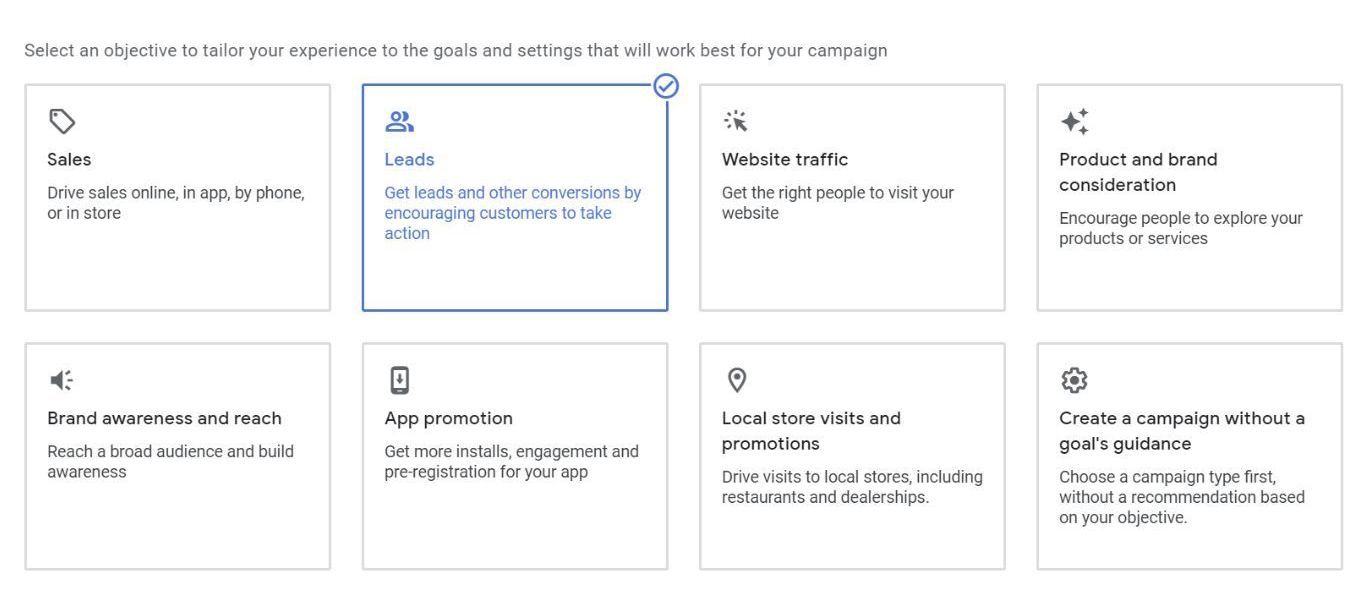
Choose a campaign type
Once you've chosen your campaign objective, you need to set your campaign type. There are several options:
- Search: The Google Search Network uses text ads and allows you to appear above the search results and at subsequent intervals throughout the search engine results page (SERP). Search ads use keywords, allowing you to create highly targeted campaigns based on search terms.
- Video: These campaigns show on YouTube and Google Partner websites and apps.
- Performance Max: Performance Max campaigns are the most versatile of Google’s campaigns. With these, you can reach users across all of Google. Your ads will appear on YouTube, Gmail, Search, Display, and across the Google Partner sites.
- Display: The Display Network uses image and video ads to showcase your brand. They’re great for brand awareness as well as promoting products or services.
- App: App campaigns let you promote your app all across Google.
- Discovery: Discovery is just as it sounds. Your ads will appear on YouTube, Gmail, Discover, and other Google properties so that users who are unfamiliar with your brand can discover you.
In this article, we will focus on the Search campaign and how to set up a successful one.
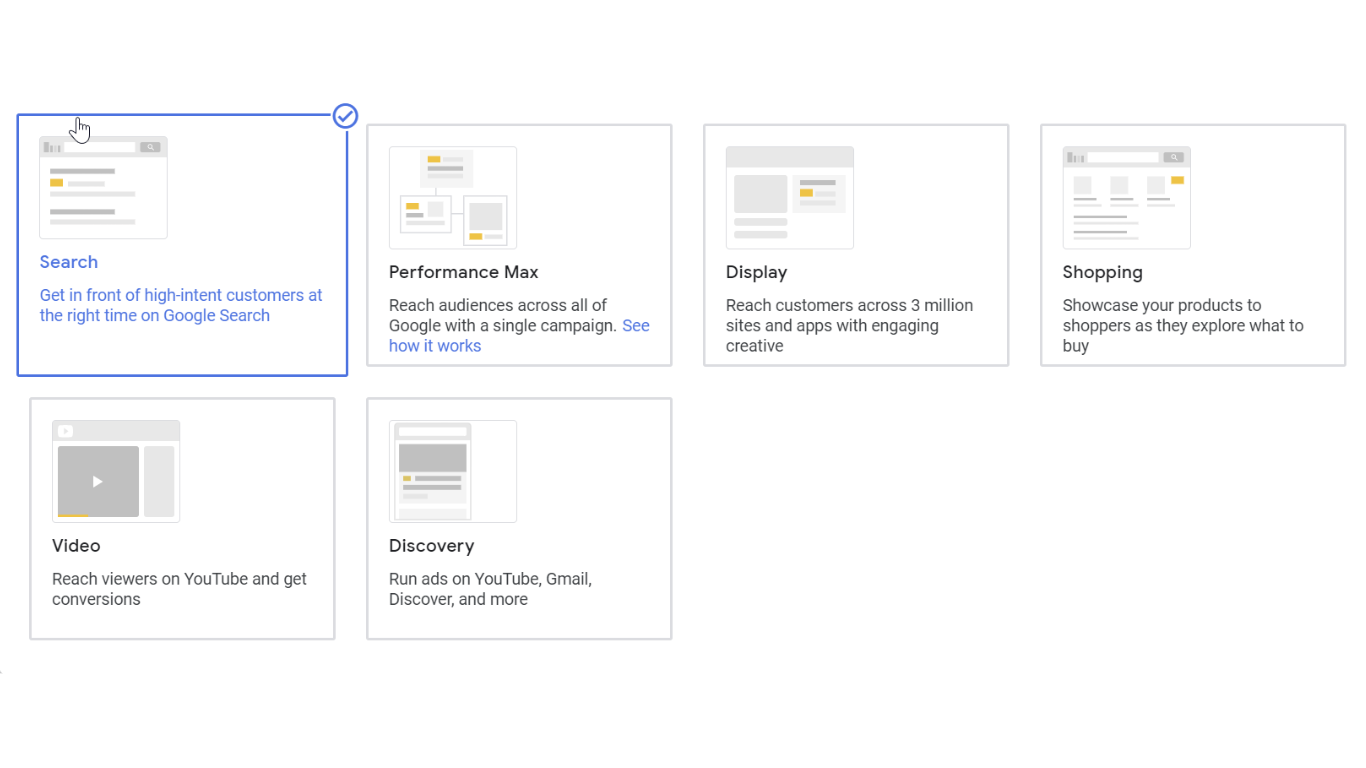
Once you have selected a campaign type, you will be prompted to name your campaign and press enter to create the rest of your campaign.
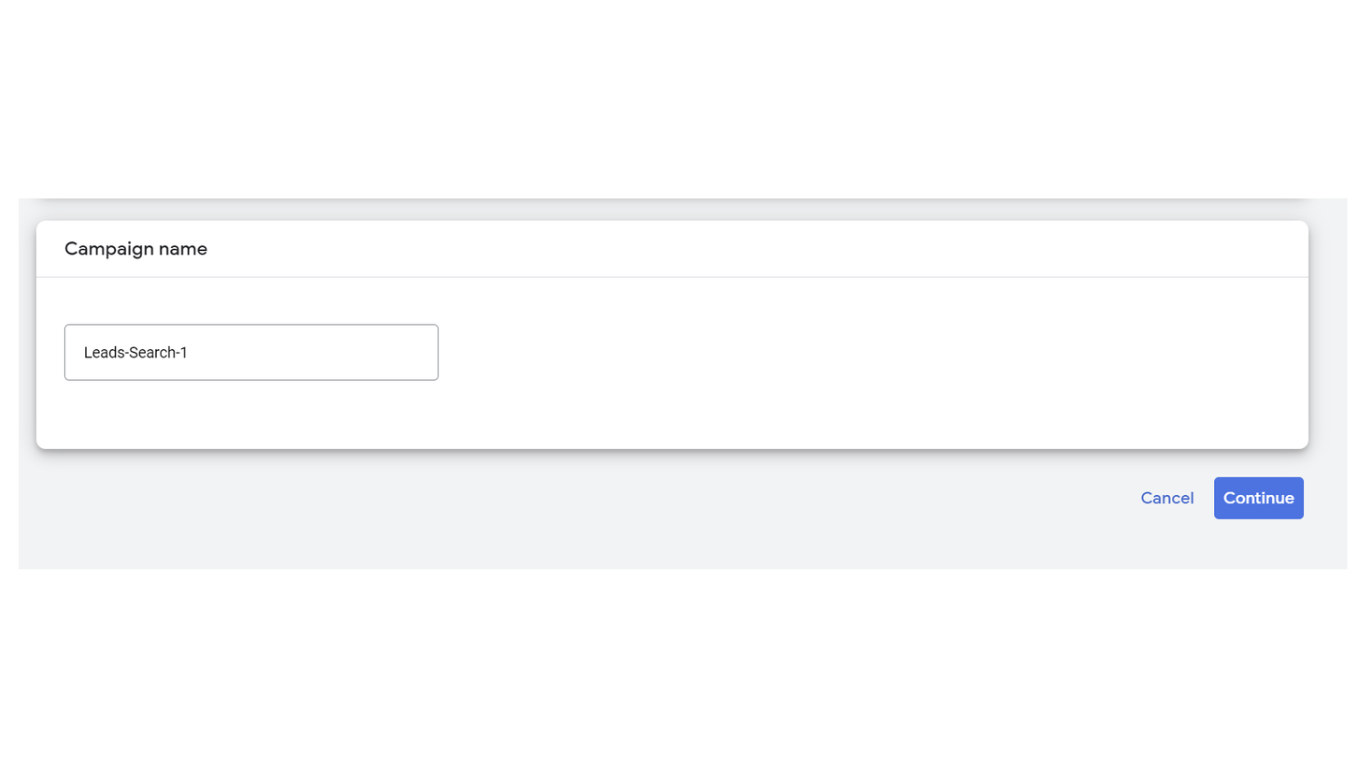
2. Build your campaign
Now, you’ll start building your campaign. This involves selecting a bidding strategy and configuring your campaign settings, including targeting and keywords. From there, you’ll create ads and set your budget.
Bidding
You’ll be asked what you want to focus on. The options are:
- Conversions
- Conversion value
- Clicks
- Impression share
You can also set a maximum cost per click bid limit or a target cost per action here.
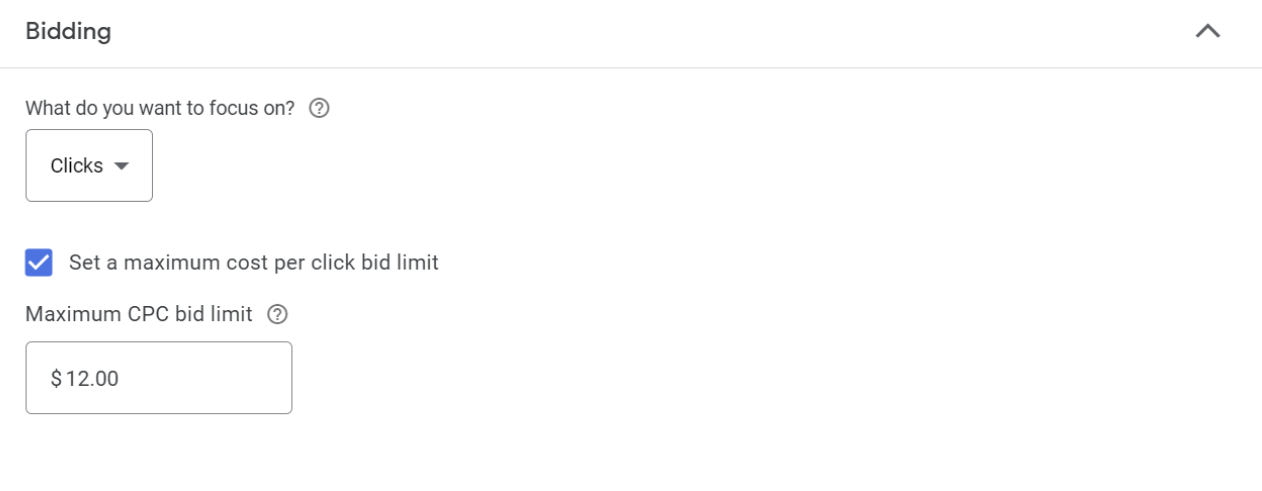
Alternative bid strategies like manual bidding are available in the settings after you create your campaign.
What is manual bidding?
Manual bidding is exactly what it implies–you’re the one adjusting your bids manually at the keyword or adgroup level. You’re telling Google the maximum amount you’re willing to bid in an auction for your keywords.
Networks
After selecting a bidding strategy, Google will ask you if you want to include your ads in the Google Search Network. The Google Search Network is made up of websites that have partnered with Google to show ads. When someone searches for a keyword that you're targeting, your ad may appear on one of these websites.
We usually don't recommend including your ads in the Google Search Partners network. This is because the quality of traffic on these websites is often lower than the quality of traffic on the Google Search Network. Additionally, you may end up paying more for clicks on ads that appear on Google Search Partners websites.
If you're not sure whether or not to include your ads in the Google Search Partners network, we recommend testing it out and seeing how it performs. You can always disable it later if you're not happy with the results.
Locations
These are the places you would like your ads to be shown. You can target regions, countries, states, and cities. You can also use a ZIP code or radius. Keep in mind the larger the area you target, the more budget you will need.
Under location options, you will find three choices related to where people are in relation to your business.
- Presence:
If you want people to be located in the area you are targeting, you should use People in or regularly in your targeted locations. (this is what we recommend for most local businesses).
- Search interest:
This will show your ads to people searching for your targeted locations. If you were a travel company looking for people researching a location, you would use "search interest".
- Presence or interest:
People in, regularly in, or who have shown interest in your targeted locations. This will allow people outside your target area to see your ads, so you will need to use it with care.
Languages
You should choose the language that your target audience speaks fluently. If you write your ads in Spanish and choose Spanish keywords, you should also choose Spanish as the language for your ads.
Here are some additional tips for choosing a language for your ads:
- Consider your target audience: Who are you trying to reach with your ads? What language do they speak fluently?
- Consider your keywords:
What keywords are you targeting? Make sure to choose a language that is relevant to your keywords.
Audiences
Audience segments are groups of people who share common interests, demographics, or behaviors. You can search here for audiences that fit your customer persona. These audiences will help you find people who are looking for your product or service.
It is best to keep this on Observation", or leave it blank for now.
Keywords
Here's where things can get tricky.
You can enter your website URL and have Google search your website for potential keywords, but this may return a lot of results. We don't recommend this approach, as it can be time-consuming and difficult to narrow down the results.
If you haven't used the Keyword Planner, you may be unsure of which keywords to use. A good starting point is to add one or two keywords that you think are most relevant to your business. You can always add more keywords later.
When you add keywords, be sure to specify the match type. Google uses quotation marks (" ") for phrase match keywords and square brackets ([]) for exact match keywords.
Here are some examples of match types:
- Phrase match: This type of match will trigger your ad when someone searches for your keyword phrase, even if they use other words or phrases around it. For example, if you add the keyword phrase "digital marketing," your ad could show up for searches like "digital marketing San Diego" or "digital marketing tips."
- Exact match: This type of match will only trigger your ad when someone searches for your keyword phrase exactly. For example, if you add the keyword phrase [digital marketing] with the exact match symbol, your ad will only show up for searches that include the exact phrase [digital marketing.]
By using the right match types, you can ensure that your ads are shown to people who are actually interested in what you have to offer.
Ad copy
Now it's time to get creative! Write at least three headlines and two descriptions. Enter the final URL for the landing page where you want people to go when they click your ad.
- Headlines: Your headlines should be clear, concise, and attention-grabbing. They should also be relevant to your keywords.
- Descriptions: Your descriptions should provide more information about your business and what you offer. They should also be persuasive and encourage people to click on your ad.
- URL: Your URL should be the final destination for people who click on your ad. Make sure it is relevant to your ad and easy to remember.
You can also add sitelinks and callouts to your ad. Sitelinks are additional links that appear below your ad. Callouts are short pieces of text that highlight your benefits or features.
Budget
Choosing the right budget is important to ensure that your ads show up and that you are performing well. We recommend starting small and adjusting your budget as you optimize your account. You should always have a daily budget that is higher than the cost of your keywords.
As a general rule of thumb, we recommend starting with a budget of at least $30 per day. However, this may not be enough for some campaigns, especially if you're targeting competitive keywords. If you're not sure how much to budget, we recommend using the Google Ads Budget Planner to get a personalized estimate.
- Use the Google Ads Performance Planner: The Google Ads Performance Planner can help you estimate how much you should spend on your campaign. Simply enter your goals, budget, and industry, and the planner will give you a suggested budget.
It's also important to remember that you can always change your budget later. If you're not seeing the results you want, you can increase your budget. And if you're spending more than you need to, you can decrease your budget.
Add billing information
After you set up your Google Ads campaign, you will be prompted to set up your billing information and add payment methods. You may also enter any promotional codes that you have from Google.
Once you have entered your billing information and payment methods, your Google Ads campaign will be ready to start.
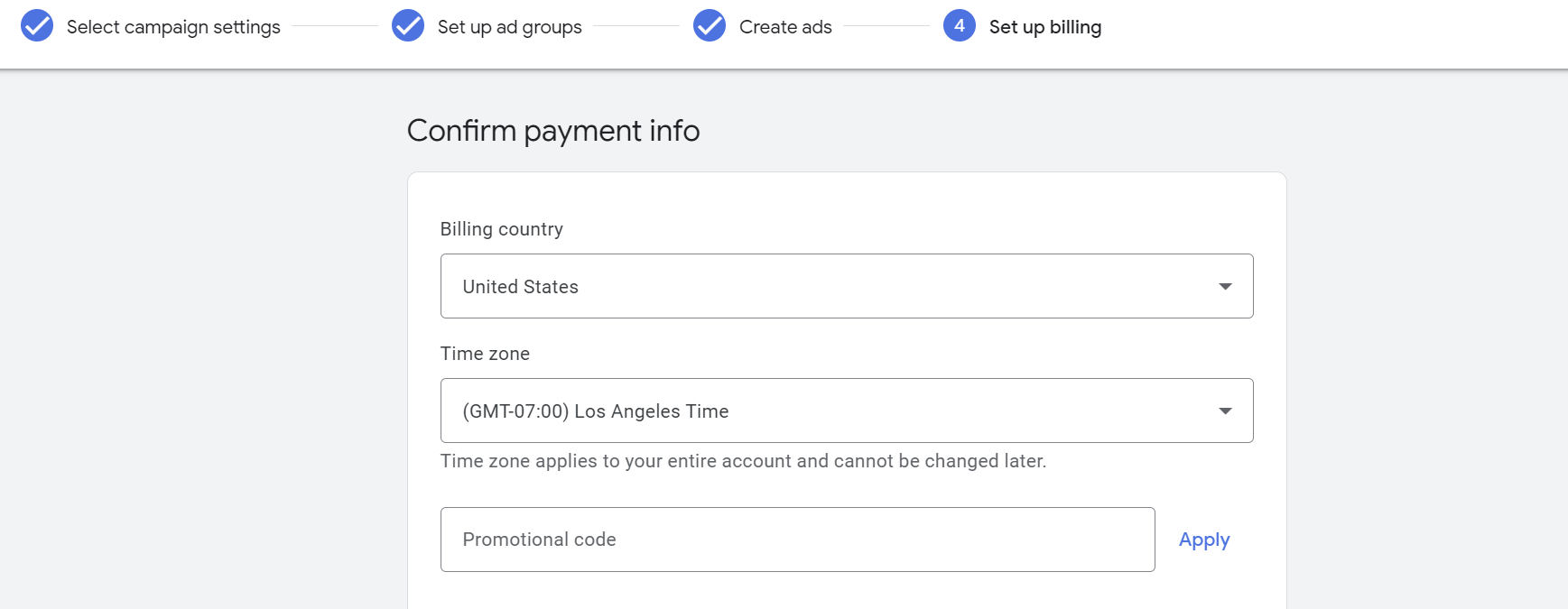
Congratulations! You have successfully set up your first Google Ads campaign. Now, it's time to finish setting up conversion tracking so you can track the success of your ads.
3. Set up conversion tracking
Conversion tracking is a critical component of any successful Google Ads campaign. It allows you to measure the results of your campaigns and see which ads are performing the best. This information can then be used to optimize your campaigns and get better results.
There are a few different ways to set up conversion tracking. You can use the Google Ads Conversion Tracking Tag, Google Analytics, Google Tag Manager, or a third-party conversion tracking service.
Here are some tips for setting up conversion tracking:
- Choose the right conversion tracking method: There are a few different ways to set up conversion tracking. Choose the method that is best for your business.
- Track the right conversions: Not all conversions are created equal. Choose conversions that are important to your business and that you can track easily.
- Track your results: Once you have set up conversion tracking, start to track your results. This information can help you to improve your campaigns and get better results.
Once you have set up conversion tracking, you can start to measure the results of your campaigns. You can see how many people are taking specific actions, such as filling out forms, making calls, or making purchases. This information can help you to improve your campaigns and get better results.
4. Optimized your campaign to get the most out of a Google Ads campaign
A profitable paid search campaign is a complex process that requires careful planning, execution, and monitoring. It's not enough to just set up your campaigns and then sit back and wait for the conversions to roll in. You need to actively monitor your campaigns and make adjustments as needed.
Understand campaign bidding strategy
Google Ads is an auction-based system where advertisers bid on keywords. The higher your bid, the more likely your ad is to show up at the top of the search results page. However, it's important to note that your bid is not the only factor that determines whether your ad is shown. Google also takes into account the quality of your ad, the relevance of your keywords, and the competition for those keywords.
There are two main types of bidding in Google Ads: automated and manual.
Automated bidding is a good option if you don't want to spend a lot of time managing your bids. Google will automatically set your bids for you based on your budget and goals. There are a number of different automated bidding strategies available, so you can choose the one that best suits your needs.
Manual bidding gives you more control over your bids. You can set your own bids for each keyword, and you can adjust your bids as needed. Manual bidding is a good option if you have a lot of experience with Google Ads and you want to get the most out of your budget.
Use negative keywords
Negative keywords are words or phrases that you don't want your ads to show up for. For example, if you sell shoes, you might want to add the negative keyword "free" to your campaign so that your ads don't show up for searches like "free shoes."
Here are some tips for using negative keywords:
- Choose the right negative keywords: Not all negative keywords are created equal. Choose negative keywords that are relevant to your business and that will prevent your ads from showing up for irrelevant searches.
- Add negative keywords to your campaigns: Once you've chosen your negative keywords, add them to your campaigns. You can add negative keywords at the campaign, or ad group level.
Optimize your ad landing page
Optimizing your landing page is important in Google Ads because it can help you to improve your conversion rate. A well-optimized landing page will be relevant to the keywords that you are bidding on, and it will be designed to convert visitors into customers.
User experience (UX) is important in all aspects of business, but it is especially important in online marketing. A good UX can help to increase click-through rates (CTRs) and conversion rates. If your ads have a good CTR but a low conversion rate, this is probably a sign that your landing page is not optimized for conversions.
Here are some tips for optimizing your landing page:
- Make sure your landing page is relevant to the keywords you are bidding on. Your landing page should be relevant to the keywords that you are bidding on. This means that the content on your landing page should be about the same topic as the keywords that you are targeting.
- Use clear and concise language. Your landing page should use clear and concise language. This will make it easier for visitors to understand what your offer is and how they can take advantage of it.
- Use strong calls to action. Your landing page should have strong calls to action. This means that you should make it clear what you want visitors to do, such as sign up for your email list, download a free ebook, or make a purchase.
- Make your landing page easy to use. Your landing page should be easy to use. This means that it should be well-organized and easy to navigate.
Improve your Quality Score
Google Ads Quality Score is a measure of how relevant and useful your ads are to the people who see them. A high Quality Score can help you get better ad placement and lower your costs per click. There are three factors that contribute to your Quality Score:
- Ad relevance: This is how relevant your ad text is to the keywords you're bidding on.
- Landing page experience: This is how relevant and useful your landing page is to the keywords you're bidding on.
- Click-through rate: This is the percentage of people who see your ad and click on it.
There are a few things you can do to improve your Quality Score:
- Choose the right keywords: Make sure you're bidding on keywords that are relevant to your business and that people are actually searching for.
- Write clear and concise ad text: Your ad text should be clear and concise, and it should accurately reflect what your website is about.
- Create a landing page that is relevant to your ad: Your landing page should be relevant to the keywords you're bidding on, and it should be easy to use and navigate.
- Track your results and make changes as needed: Monitor your Quality Score and make changes to your ads and landing pages as needed.
Use assets (formerly known as Ad Extensions)
Ad extensions are additional pieces of information that you can add to your ads. For example, you can add your phone number, address, or website address to your ads. Ad extensions can make your ads more visible and can help you to get more clicks.
Your options for assets are:
- Sitelinks – link to other pages on your site
- Location extensions – they show your Google My Profile location
- Structured snippets – allow you to show amenities, services, brands, etc.
- Price extensions – show prices for products or services
- Promotion extensions – feature special offers and deals
- Image extensions – images that enhance your ads
- Call extensions – allow users to click to call on mobile devices or see a number they can dial manually
- App extensions – an app download link
- Callouts – add benefits, new features, and more information
- Affiliate location – gives the ability to list third-party retailers
- Lead form – gives a form where users can submit their contact information
The takeaway
Setting up a successful Google Search campaign can be a daunting task, but it doesn't have to be. By following the tips in this article, you can create a campaign that will help you reach your target audience and achieve your marketing goals.
At GreenFlow SEM Digital Marketing, we can help you with every step of the process, from keyword research to campaign optimization. We offer a free consultation, so don't hesitate to contact us today to learn more about how we can help you succeed with Google Search.
We provide a wide range of Website and Advertising services to meet your needs, our services include, website design, Google Ads & Pay-Per-Click (PPC) Management, and Local Search Engine Optimization (SEO).

All Rights Reserved | GREEN FLOW SEM

